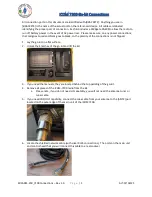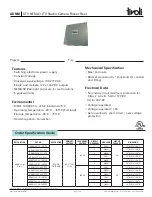
1-14
888-2523-001
7/26/05
WARNING: Disconnect primary power prior to servicing.
Section 1 Introduction
ATLAS Analogue
Vision Specifications
Units
Conditions
Notes
Published Specification Value
Frequency Response vs Brightness
dB
Measured using a 20% amplitude swept video
modulation with pedestal set at 10%, 50% and 90%
APL. All percentages relative to a blanking to white
excursion.
± 0.75 or better
Differential Gain
%
Measured with a 5-step staircase signal from 75%
to 12.5% of peak sync level. Subcarrier modulation
level at 12.5% peak-to-peak
< 5%
Exciter Spec.
< 3
Differential Gain vs APL
%
Average picture level defined as the pedestal level
over 4 horizontal lines set to 10%, 50% and 90% of
maximum white level with every 5th line activated
with a standard 5-step staircase signal.
< 5
Differential Phase
deg
Measured with 5-step staircase signal as in
Differential Gain.
< 3 degrees
Exciter Spec.
< 3
Incidental Carrier Phase Modulation
deg
Carrier phase variation from reference white to sync
tip relative to blanking.
± 2 or better
Luminance Non-linearity
%
Measured with a 5-step staircase signal. Test Signal
#3 CCIR Rec. 421-3.
<10
System CCIR-M, NTSC (Relative to
FCC standard Curve)
nS
0.2-2.1 Mhz
< ± 30
nS
3.58 Mhz
< ± 30
nS
4.18 Mhz
< ± 30
2T Pulse K-Factor
%
< 2
15 kHz Bar tilt
%
< 2
50 Hz Bar tilt
%
< 2
Signal-to-Noise Ratio (Unweighted)
dB
Measured with VM700A with high-pass filter, Low
Pass filter and Sound Trap ON.
> 56 dB (dual sound)
Exciter Spec.
> 54
Signal-to-Noise Ratio (Weighted)
dB
Measured with VM700A with weighting filter, high-
pass filter, low Pass filter and Sound Trap ON.
> 63 dB (dual sound)
Exciter Spec.
> 60
Variation of Output Power
%
Total peak-to-peak variation of peak sync voltage
during one field, using a flat-field test signal, per EIA
508.
< 2
Regulation of Output Power
%
Variation of peak output power with a change in
average picture level from black to white (0% to
100% APL).
< 3
In-Band Intermodulation Products
dB
Measured using 100% modulated ramp with 40 IRE
subcarrier amplitude, relative to peak sync.
< - 62 dB
Exciter Spec.
-58 Max, -60 typical
Out-of-Band Intermodulation Products
dB
Relative to peak visual power. Measured at the
output of Harris-supplied IMD filter
< -60
Carrier Frequency Stability
Hz/month
+/-150
Equivalent Envelope Delay
Summary of Contents for ATLAS ANALOGUE
Page 4: ...iv 888 2523 001 7 26 05 WARNING Disconnect primary power prior to servicing...
Page 6: ...vi 888 2523 001 7 26 05 WARNING Disconnect primary power prior to servicing...
Page 8: ...viii 888 2523 001 7 26 05 WARNING Disconnect primary power prior to servicing...
Page 10: ...x 888 2523 001 7 26 05 WARNING Disconnect primary power prior to servicing...
Page 14: ...Table of Contents continued 4...
















































